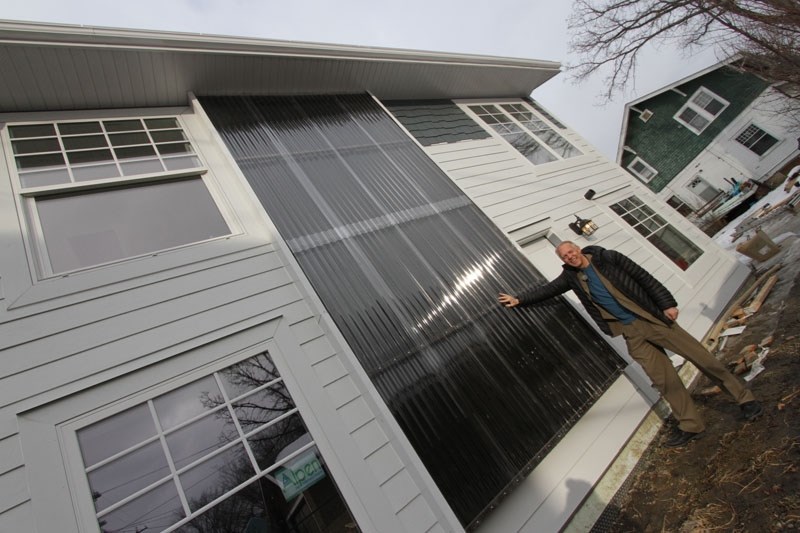A former St. Albert resident is inviting people to check out a new net-zero home he helped build – one that has a sun-catching wall and a giant water bottle.
The eco-audit firm Carbon Busters is hosting an open house today for Edmonton’s first zero-carbon laneway house.
The house is a 1,276 square-foot two-level laneway house commissioned by Andreas Hengst and Karly Coleman, said Carbon Busters founder and former St. Albert resident Godo Stoyke. The house is half-garage, half-suite.
Like most net-zero homes, the home is designed to produce zero net greenhouse gas emissions during a year.
What’s unique about this one is that it uses an air-to-liquid heating system that stores energy for use later, said David Dodge, a former Gazette reporter who filmed a segment on the home for Green Energy Futures. It also has an innovative solar wall that harvests solar energy at very low cost.
“It kind of looks like siding.”
Stoyke said net-zero homes are highly efficient but use and create lots of electricity, making it tough to integrate them into a power grid.
“The idea of this building is to create a building that helps renewables to be integrated more easily into the grid by being able to control this demand through storage,” he said.
The home has a 2,600-litre storage tank that traps heat using water and glycol, Stoyke said. It’s similar to a geothermal system, but a lot cheaper.
The tank is hooked to an air-source heat pump (think reverse air-conditioner) that sucks heat out of the outside air and transfers it to the tank, Stoyke said. The storage lets the system collect heat when it’s hot for release when it’s cold. The tank provides enough energy for both space and water heating in the home without the need for natural gas or oil.
Hooked into the tank is a large solar wall on the outside of the house – a black metal panel covered with Plexiglas. Light heats the air between the Plexiglas and the panel, and the heat pump dumps this heat into the tank, Stoyke said.
Stoyke is working with the University of Calgary to create a statistical model to govern when the tank system harvests and expends heat and to do a life-cycle analysis of the home’s economic and environmental impacts.
The home also features 6.76 kW of solar electric panels, electric car chargers, and copious amounts of insulation – the roof is rated at R105, which is almost three times what’s required by the building code for roof insulation.
The home costs about $50,000 more than a regular one, which is similar to other net-zero homes, Stoyke said. The owners should recover this cost in energy savings in around 15 years.
Dodge said he was “blown away” by what he saw in the home, and loved the inexpensive way the solar wall integrates solar power into the structure.
“It makes me believe we could build all new homes as net-zero in the not-too-distant future.”
The open house runs from 1 p.m. to 4 p.m. this Feb. 20 at 10822 123 St. NW in Edmonton. Call 780-437-0023 for details.
A solar panel can make you four times more money than most other investments at the bank, suggests a speaker at an upcoming talk.
The Solar Energy Society of Alberta is hosting a free talk this Feb. 25 on small-scale investment opportunities in solar power.
While most solar systems still take 10 to 15 years to pay off, the cost to put one on your roof continues to fall, said Rob Harlan, the group’s executive director.
“It’s approaching a point where people would consider it a good investment.”
Next week’s talk will have John Maude of Wetaskiwin’s Maude Financial Inc. discussing the financials of solar power.
Maude said he’s had a 10 kW system on his home for 10 years now that produces about twice as much power as he uses.
“On my system, even with the low price of energy right now, I’m getting a 4.3 per cent return on my investment,” he said – much better than the one per cent you can get through a 10 year-bond or a high-interest account right now. The cash you make from selling excess solar power is also tax-free.
Only about 25 per cent of Edmonton and St. Albert residents own a roof that’s suitable for solar, Harlan said. That’s why next week’s talk will also feature sessions by groups such as the Solar Power Investment Cooperative of Edmonton that let people invest in solar panels that aren’t on their property.
The talk starts at 7 p.m. Thursday at MacEwan University’s CN Theatre (Room 5-142). Solaralberta.ca has the details.




